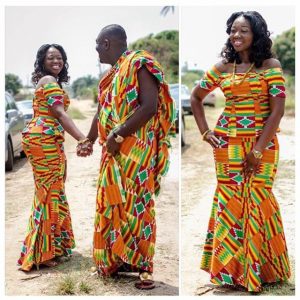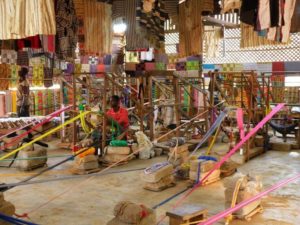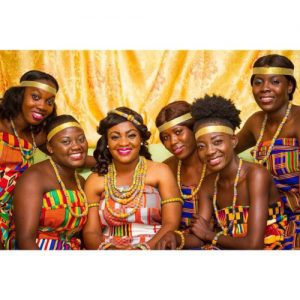
Kente: Giving tradition a meaning
By Sheila A. WILLIAMS
Oral traditional has it that a man named Ota Karaban and his friend Kwaku Ameyaw from the town of Bonwire (the leading Kente weaving centre in Ashanti), learned the art of weaving by observing a spider weaving its web. Taking a cue from the spider, they wove a strip of raffia fabric and later improved upon their skill.
The discovery was reported to their chief Nana Bobie, who in turn informed the Asantehene (Ashanti King) at that time. The Ashanti craftsmen later learned the weaving skills from other peoples living among them and later developed their unique styles of cloth.
Kente was developed by the Ashantis in the 17th Century AD, with weaving in Africa dating back to around 3000 B.C.
Materials and Techniques
Weaving is done by hand by the weavers themselves or by others who have specialized technics in weaving. Their apparatus, like designs in a cloth, have symbolic meanings and are accorded a great deal of respect.
Yarns for weaving come in a variety of forms and qualities. In the past, yarns were either spun from locally grown cotton or unravelled from cotton and silk cloths imported from Europe and Asia. Today, factory made cotton, silk or spun rayon yarns are obtained from factories in Ghana and outside Ghana. Various colours of yarns may be combined in particular ways to reflect the symbolic significance of the cloth. Quality of yarns used in weaving a particular cloth reflects on the level of prestige associated with the cloth. Silk yarns are usually considered the most prestigious and are therefore the most highly valued.
 Adding true sense of tradition in our marriage with Kente
Adding true sense of tradition in our marriage with Kente
Silk cloths, in the past were reserved for royalty and the wealthy. An average width of a strip is four inches. Several strips are carefully arranged and hand-sewn together (some weavers use sewing machines in recent times) to obtain a desired and unique size. Tradition has it that Kente is woven mainly by men. Women, in the past, played a significant role by spinning raw cotton into yarns, dying yarns into desired colours, sewing strips together to form large cloths and assisting in the marketing of the cloths. Today, factory spun yarns have replaced hand-spun yarns, and therefore, the woman’s role is mainly in the area of sewing strips together and marketing the cloth.
Aesthetics and Usages
Kente in the cultural context of use is more than just a cloth. Kente is a visual representation of history, philosophy, ethics, oral literature, religious belief, social values and political thought. Originally, its use was reserved for their royalty and limited to special social and sacred functions. When its production increased, it became more accessible to those who could afford to buy it.
The prestigious status of Kente has been maintained over the years and has continued to be associated with wealth, high social status and cultural sophistication. A Kente weaving factory in Kumasi
A Kente weaving factory in Kumasi
In spite of the production of both the hand woven and machine printed Kente, the authentic forms of the cloth are still regarded as a symbol of social prestige, nobility and a sense of cultural sophistication.
In the Akan traditional protocol, Kente is reserved for very important and special social or religious occasions. In many cases the use of Kente has a sacred intent. It may be used as a special gift item during such rites and ceremonies as child naming, puberty, graduation, marriage and soul-washing. It may also be used as a symbol of respect for the departed souls during burial rites and ancestral remembrance ceremonies.
How Kente is worn
There are gender differences in how the cloth is worn. Averagely, men-size cloth measures 24 strips (8 ft. wide) and 12 ft. long.
Men usually wear one piece wrapped around the body, leaving the right shoulder and hand uncovered, in a toga-like style. Some men wear a jumpa, a kind of collarless shirt over which the cloth is wrapped.
Women may wear either one large piece or a combination of two or three pieces of varying sizes ranging from 5-12 strips (20 inches to 48 inches wide) and an average of 6 ft. long. These are wrapped around the body with or without a matching blouse. In some cases, elderly women with high social status may wear a large piece in toga-like fashion just as men do. Within traditional societies, age, marital, and social standing may determine the size and design of cloth an individual would wear. Social changes and modern living have brought about significant changes in how Kente is used and worn.
Kente Symbolism
Kente is used not only for its beauty but also for its symbolic significance. Each cloth has a name and a meaning; and each of the numerous patterns and ideas has a name and a meaning.
Names and meanings are derived from historical events, individual achievements, proverbs, philosophical concepts, oral literature, moral values, social code of conduct, human behaviour and certain attributes of plant and animal life. Patterns and ideas are generally created by weavers who also assign names and meanings to them. Forms, names and means of such patterns and ideas are sometimes given by weavers who may obtain them through dreams and during contemplative moments when they are said to be in communion with the spiritual world. Sometimes, kings and elders may ascribe names to cloths that they specially commission.
Generally, names are based on the warp arrangements of the cloth, however, in some instances, both warp and weft arrangements determine a name of a cloth, with over 300 different types of cloth designs, each with its name. Each cloth design comes with numerous variations-in colour and distribution of ideas.
Colour Symbolism
Colour symbolism within the Akan culture affects the aesthetics of Kente. Colours are chosen for both their visual effect and their symbolic meanings. A weaver’s choice of colours for both weft and warp designs, may be dictated either by tradition or by individual aesthetic taste. There are gender differences in colour preferences, dictated by tradition, individual aesthetic taste and by spirit of the occasion.
As a convention rather than a strict code of dress, women tend to prefer cloths with background or dominant colours that are lighter or tinted, such as white, light yellow, pink, purple, light blue, light green and turquoise. Generally, men tend to prefer cloths with background or dominant colours that are on the shaded side, such as black, dark blue, dark green, maroon, dark yellow, orange and red.
Social changes and modern living have, however, led some people to ignore these traditional norms, resulting in colour choice based on individual taste.
YELLOW symbolizes sanctity, preciousness, royalty, wealth, spirituality, vitality and fertility.
PINK symbolizes tenderness, calmness, pleasantness, and sweetness. According to Akan social thought, these attributes are generally considered as essential aspects of the female essence.
RED is associated with blood, sacrificial rites and the shedding of blood. Red-eyed mood means a sense of seriousness, readiness for a serious spiritual or political encounter, sacrifice and struggle.
BLUE is associated with the blue sky, the dwelling of the Supreme Creator. It is therefore used in a variety of ways to symbolize spiritual sanctity, good fortune, peacefulness, harmony and love related ideas.
GREEN symbolizes growth, vitality, fertility, prosperity, fruitfulness, abundant health and spiritual rejuvenation.
PURPLE is associated with rituals and healing purposes. It is also associated with feminine aspects of life. Purple cloths are mostly worn by females.
WHITE is associated with ancestral spirits, deities and other unknown spiritual entities such as ghosts. It is used in combination with black, green or yellow to express notion, spirituality, vitality and balance.
SILVER is associated with the moon, which represents the female essence of life; it symbolizes serenity, purity and joy. Silver ornaments are usually worn by women and are used in the context of spiritual purification, naming ceremonies, marriage ceremonies and other community festivals.
GOLD derives its significance from the commercial value and social prestige associated with the precious mineral. It symbolizes royalty, wealth, elegance, high status, supreme quality, glory and spiritual purity.
BLACK symbolizes an intensified spiritual energy, communion with the ancestral spirits, antiquity, spiritual maturity and spiritual potency.
Kente is a royal cloth of prestige reserved for only special occasions, go grab yourself half piece of Kente and enjoy that royal feeling that comes with prestige because you are a royal.
 Some chiefs displaying resplendent Kente styles and deigns
Some chiefs displaying resplendent Kente styles and deigns
Writers e-mail address: eyram.williamsgh@gmail.com





























